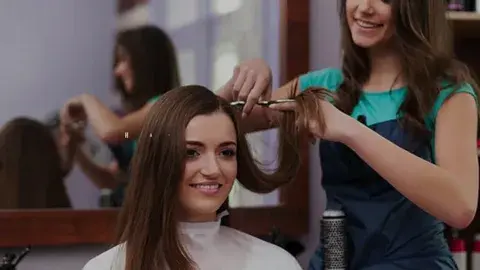If you’re in the beauty industry or even just starting out, you’ve probably heard a lot about beauty salon capes. But what are they, and why do you need one? Maybe you’re still unsure about which cape to choose for your salon or how to pick the right one for specific services. Don’t worry—I’ve got you covered.
Beauty salon capes are more than just a stylish accessory—they’re an essential part of providing a comfortable and hygienic experience for your clients. From protecting them from hair clippings to ensuring their comfort during a long appointment, the right cape can make a huge difference. In this guide, I’ll walk you through everything you need to know about beauty salon capes, from choosing the right fabric to maintaining them in tip-top shape.
What Are Beauty Salon Capes and Why Do You Need Them?
A beauty salon cape is typically worn by clients during haircuts, hair coloring, or other beauty treatments to keep their clothes clean and dry. It’s like a shield against stray hairs, water, and any other mess that could happen during the appointment. Whether you’re cutting hair, applying a facial mask, or dyeing someone’s hair, a cape ensures that your client’s clothing stays spotless.
Without a salon cape, your clients would likely leave covered in hair or product, which is not exactly the best look. Plus, it’s just uncomfortable for them. A high-quality beauty salon cape ensures both comfort and cleanliness. But choosing the right one isn’t as straightforward as it may seem, so let’s dive deeper into what makes a great cape.
Types of Beauty Salon Capes
Not all capes are created equal. In fact, the type of cape you choose can make a huge difference in your salon’s day-to-day operations. Here are the main types you’ll come across:
1. Haircutting Capes
These are the classic capes you see in most salons. They’re designed specifically to keep hair off your client’s clothing. They come in various materials such as nylon, polyester, and cotton blends. The key is to pick a material that’s lightweight, durable, and easy to clean.
2. Coloring Capes
When your clients are getting their hair colored, you need a cape that’s both waterproof and resistant to staining. These capes are often made from a plastic or vinyl material, making them easy to wipe clean after every use.
3. Styling Capes
These capes are generally used when you’re blow-drying or styling hair. They’re designed to be lightweight, breathable, and comfortable for the client. You’ll often see these made from materials like satin or nylon.
4. Facial or Treatment Capes
When your client is getting a facial or some other beauty treatment, you might opt for a smaller, more fitted cape. These are usually made of cotton or microfiber, providing comfort and ease for the client during longer sessions.
5. Protective Capes
Some salons use capes that are designed to protect the client’s skin during treatments. These often feature an extra layer of protection against products that might stain clothing or skin, such as hair dye or lotions.
Material Matters: Choosing the Right Fabric for Beauty Salon Capes
The fabric you choose for beauty salon capes is incredibly important. After all, a cape that’s too stiff, too heavy, or too thin could end up ruining the experience for both you and your client. So, let’s break down the common materials you’ll find in beauty salon capes:
1. Nylon
Nylon is one of the most common materials for beauty salon capes. It’s lightweight, durable, and easy to clean. It’s also resistant to water and hair, which makes it an excellent choice for most hair services. However, it can sometimes feel a little static-prone, which is something to consider if your client has long hair.
2. Polyester
Polyester capes are similar to nylon, but they tend to feel a bit more comfortable and breathable. They’re often resistant to wrinkles and stains, which is a huge plus. They also dry quickly, making them ideal for busy salons.
3. Vinyl
If you’re doing hair color or other treatments that might require waterproof protection, vinyl is the material of choice. It’s easy to wipe clean and will keep hair dye and other products from staining your client’s clothing. Just be aware that vinyl can sometimes feel a little stiff or uncomfortable for longer services.
4. Cotton and Cotton Blends
Cotton is a great option if you’re looking for comfort and softness. It’s breathable and natural, making it ideal for clients with sensitive skin. It’s also more eco-friendly, which is a growing concern for many salons. The downside? Cotton can absorb hair dye and other products, so it may not be the best option for coloring services.
5. Satin
For styling or blow-drying, satin is a luxurious option that adds a little touch of elegance to your salon. It’s smooth, shiny, and feels fantastic against the skin. While satin capes are often lightweight, they can be harder to clean than other materials.
How to Choose the Best Beauty Salon Cape for Your Clients
With so many options on the market, how do you know which cape is the best for your salon? Here are a few things to consider before making your purchase:
1. Comfort
The comfort of your clients should be your top priority. A cape that’s too tight, too loose, or uncomfortable can leave your clients feeling irritable, which isn’t the vibe you want in your salon. Always make sure your capes fit well and don’t restrict movement.
2. Durability
A cape that doesn’t last long or tears easily can be a headache for any salon owner. Make sure you’re investing in a high-quality cape that can withstand frequent use, washing, and drying. The last thing you want is a cape that falls apart after just a few uses.
3. Ease of Cleaning
Salons are busy places, and cleaning up after each client is a must. Choose capes that are easy to wipe down or machine washable. You don’t want to spend hours scrubbing stains off your capes or dealing with stubborn hair that won’t come off.
4. Size
Not all clients are the same size, so make sure you’re selecting capes that can accommodate different body types. Adjustable capes are often a good choice because they can be customized to fit each client comfortably.
How to Care for Your Beauty Salon Capes
Proper care of your beauty salon capes is essential for extending their lifespan and keeping them in top condition. Here are some tips for maintaining your capes:
1. Regular Washing
Wash your capes after every use to keep them fresh and clean. For nylon and polyester capes, a gentle machine wash should be enough. For vinyl or plastic capes, wipe them down with a damp cloth after each use.
2. Avoid Harsh Detergents
When washing your capes, avoid using harsh detergents or bleach, as these can damage the fabric over time. Stick to mild detergent and air dry whenever possible.
3. Storage
Proper storage is key. Hang your capes up or fold them neatly to avoid wrinkles or creases. If you’re using vinyl or plastic capes, avoid storing them in direct sunlight, as it can cause the material to crack or fade.
FAQs About Beauty Salon Capes
1. Can I use a regular cape for hair coloring?
No, you should use a special coloring cape for hair coloring to prevent staining. These capes are usually waterproof and designed to withstand products like dye and bleach.
2. How often should I replace my beauty salon capes?
With proper care, your beauty salon capes should last a long time. However, if you notice that they’re starting to wear down, get damaged, or no longer fit your clients properly, it’s time to replace them.
3. Can I buy disposable beauty salon capes?
Yes, disposable capes are available and can be used for one-time services. They are convenient for salons that want to ensure the highest level of hygiene between clients.
Conclusion: Beauty Salon Capes Are Essential for Your Salon
In conclusion, beauty salon capes are much more than a simple accessory. They provide comfort, cleanliness, and protection for your clients, making them an essential part of any salon’s toolkit. Whether you’re choosing a cape for haircuts, coloring, or facials, the right material and fit can make all the difference.
When you invest in high-quality beauty salon capes, you’re investing in your salon’s success. Make sure to choose a cape that meets your clients’ needs, and with proper care, your capes will serve you well for years to come. So, don’t overlook this small yet crucial item—it can have a big impact on the overall experience your clients have in your salon.
Read More: SkinCareSensation

